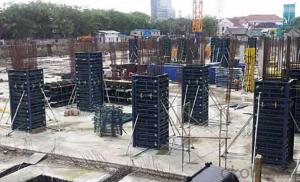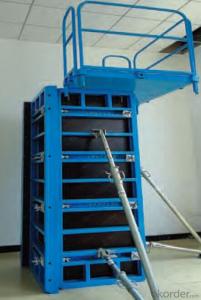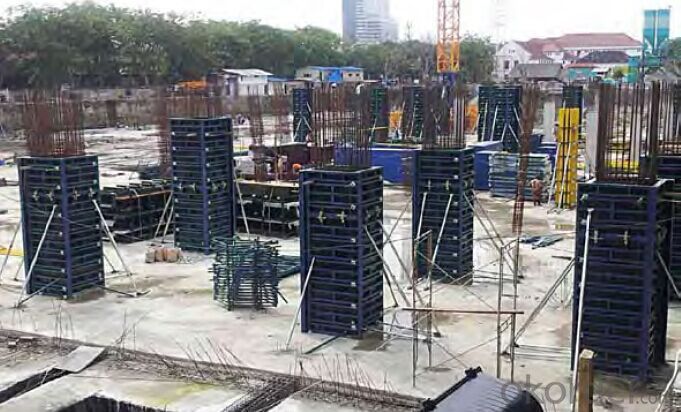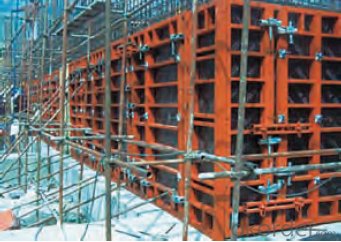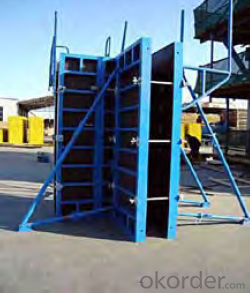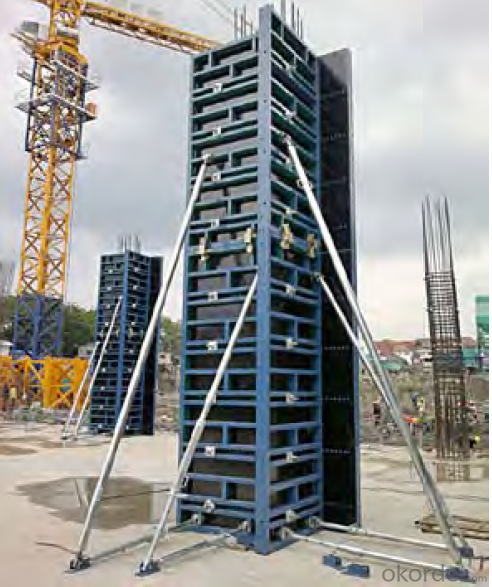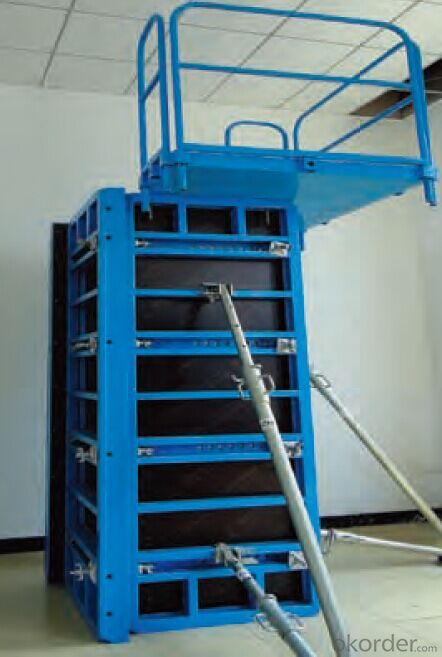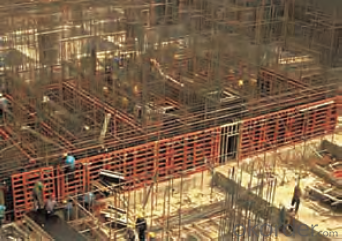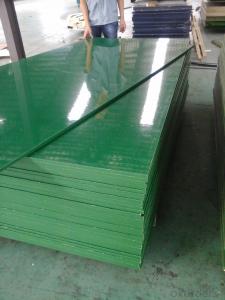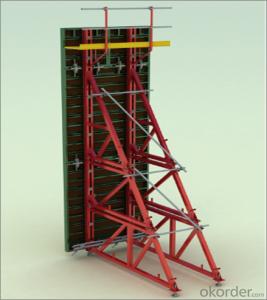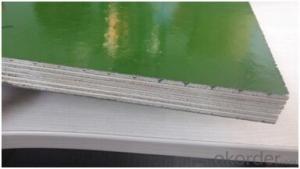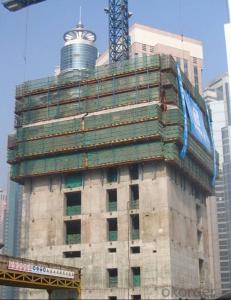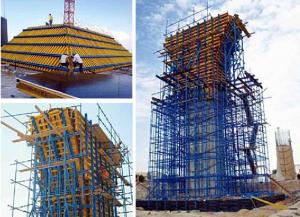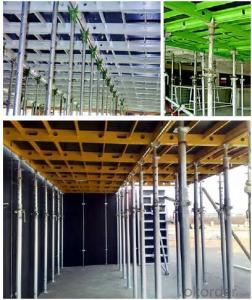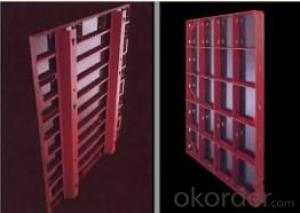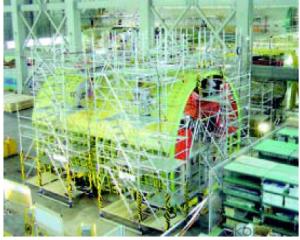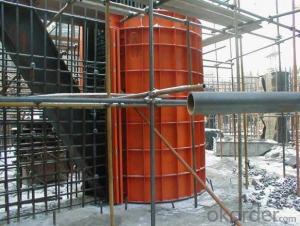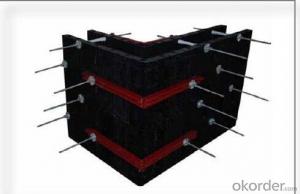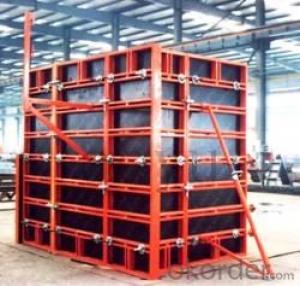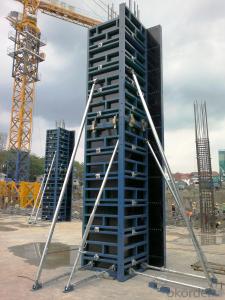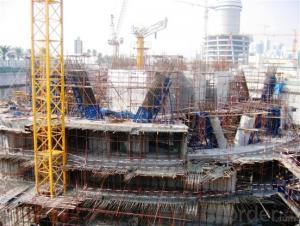Steel Frame Formwork of Avaliable Repeatedly Turnover
- Loading Port:
- Shanghai
- Payment Terms:
- TT OR LC
- Min Order Qty:
- 1 m²
- Supply Capability:
- 100000000 m²/month
OKorder Service Pledge
OKorder Financial Service
You Might Also Like
1. Structure of Steel Frame Formwork GK120
There is a prizing part designed in the corner, which can help to position and remove formwork easily.
The plywood is screwed on from the back when connecting frame and plywood, so the surface of the finished concrete is perfect.
The formwork series are a complete system with a full set of accessories, and can be set up flexibly according to project demand.
2. Main Features of Steel Frame Formwork GK120
Light weight
High strength
High standardized system
Easy connection with adjustable steel clamp
Convenient and fast corner formwork
Flexible to assemble and application
3. Steel Frame Formwork GK120 Images
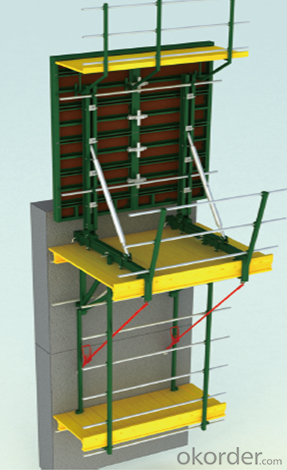
4. Steel Frame Formwork GK120 Specification
-The steel frame formwork is plywood covered with hollow steel. The plywood is 18 mm thick.
-The frame is highly strengthened, and the wall formwork can bear lateral pressure 60 KN/m2 while the column formwork can bear 80 KN/m2.
-As a standardized system, it is flexible to assemble , wood batten can be filled to satisfy the need f of non-standard size.
-The adjustable steel clamp is convenient to use, and can hold tightly.
-There is a prizing part designed in the corner, which can help to position and remove formwork easily.
-The plywood is screwed on from the back when connecting frame and plywood, so the surface of the finished concrete is perfect.
-The formwork series are a complete system with a full set of accessories, and can be set up flexibly according to project demand.
5. FAQ of Steel Frame Formwork GK120
1) What can we do for you?
.We can ensure the quality of the vinyl banner and avoid extra expenses for customers.
.We can provide you the professional design team.
.We can provide fashionable and newest styles for you.
.We can design the artwork for you.
. Please feel free to customize.
2) What promises can be done by us?
. If interested in Steel Frame Formwork GK120, please feel free to write us for any QUOTE.
. If printing required, please advise asap because the whole set need much more time to complete.
. Please DO check goods when courier knocks your door and contact us asap if any issue.
3) What about of our after-sale service?
. Response will be carried out in 24hours after receiving any complain or request.
. Steel Frame Formwork GK120 cost can be refund after order is confirmed.
. If the products are not based on the requirements, there will be the relevant compensations made for you.
4) What about the package and shipping time?
.Packing: As Customer's Requirements
.Shipping: We have various shipping ways for our customers, such as express which including TNT, DHL, FEDEX, UPS, EMS, etc. ; by air/ sea, and we are VIP of these express.
.Shipping time:
Normally small orders, it just 10-15 business days to arrive your hand; When comes to the customs declaration, it may need 7 days.
Other mass qty of Steel Frame Formwork GK120, we send them out by sea or by air to sea port or air port to save some shipping freight for our customers. By ocean, it may need 45~60days, by air, it may need 25~40days.
- Q: Does steel frame formwork require any specific concrete pouring techniques?
- Concrete pouring techniques must be specific when using steel frame formwork. The purpose of the steel frame formwork system is to provide support and structure while the concrete is poured and cured. To begin, it is crucial to align and secure the formwork properly before pouring the concrete. This precaution prevents any leakage or distortion during the pouring process. It is also important to check for any gaps or spaces in the formwork that may cause the concrete to seep through. Next, careful planning of the concrete pouring technique is necessary to ensure that the concrete is uniformly distributed and consolidated within the formwork. This can be achieved by using appropriate pouring methods, such as the continuous pour, where the concrete is poured continuously in one operation, or the layer-by-layer pour, where the concrete is poured in multiple layers and compacted in between. In addition, it is essential to use appropriate vibration techniques to eliminate air pockets and ensure proper compaction of the concrete. Vibrators can be used, either manually or mechanically, depending on the size and complexity of the formwork. Furthermore, proper curing techniques should be employed to facilitate the hardening and strength development of the concrete. This may involve covering the formwork with a curing membrane or applying a curing compound to maintain moisture and temperature levels. In conclusion, specific concrete pouring techniques are necessary when using steel frame formwork to guarantee the structural integrity and quality of the final concrete structure. Proper alignment, uniform pouring, compaction, and curing techniques are vital for achieving the desired results.
- Q: How does steel frame formwork affect the overall sustainability goals of a construction project?
- The overall sustainability goals of a construction project can be significantly impacted by the use of steel frame formwork. Firstly, steel is an incredibly durable material that can withstand the harsh conditions of construction, resulting in a longer lifespan for the formwork system. This increased durability reduces the need for frequent replacements, which in turn saves resources and decreases waste. Additionally, steel frame formwork is reusable, meaning it can be dismantled after use and utilized again in future projects. This not only reduces the demand for new formwork materials but also minimizes the amount of waste generated during the construction process. By promoting the reuse of formwork, steel frames contribute to a circular economy approach that aims to reduce resource consumption and waste generation. Furthermore, the use of steel frame formwork facilitates efficient and precise construction processes. The formwork system is designed to provide accurate dimensions and smooth finishes, resulting in reduced material waste and energy consumption. Moreover, steel is a highly recyclable material, meaning that once it reaches the end of its life cycle, it can be easily recycled and used in the production of new steel products. This reduces the demand for virgin materials and the associated environmental impact. Lastly, steel frame formwork offers flexibility in design and construction, enabling innovative and sustainable building practices. Its strength and versatility allow for the construction of complex and efficient structures, such as high-rise buildings or large-span structures, which can maximize energy efficiency and minimize the overall environmental impact of the project. In conclusion, the use of steel frame formwork positively impacts the sustainability goals of a construction project by promoting durability, reusability, efficiency, and recyclability. Its utilization contributes to the reduction of resource consumption, waste generation, and environmental impact, aligning with the principles of sustainable construction practices.
- Q: Can steel frame formwork be used for both permanent and temporary formwork systems?
- Yes, steel frame formwork can be used for both permanent and temporary formwork systems. Steel frame formwork is durable, strong, and can withstand the pressures exerted by concrete during the pouring and setting process. This makes it suitable for permanent structures where the formwork needs to remain in place as a permanent part of the structure. On the other hand, steel frame formwork is also easily adjustable and reusable, making it suitable for temporary formwork systems. It can be quickly assembled and disassembled, allowing for efficient construction processes. Additionally, the robust nature of steel frame formwork ensures that it can be used repeatedly without compromising its structural integrity. Overall, steel frame formwork provides flexibility and versatility, making it suitable for both permanent and temporary formwork systems.
- Q: How does steel frame formwork affect the quality of the finished concrete surface?
- Steel frame formwork can have a significant impact on the quality of the finished concrete surface. Firstly, the use of steel frame formwork ensures precise and accurate alignment of the formwork, resulting in a straight and even concrete surface. This is especially important for concrete structures that require high levels of accuracy, such as walls, columns, and slabs. The rigidity and stability of steel frame formwork also prevent any movement or deformation during the pouring and curing process. This helps to eliminate any potential formwork deflection or concrete slump, resulting in a smooth and uniform finish. Additionally, the steel frame formwork provides excellent support and containment for the freshly poured concrete, ensuring that it does not leak or sag. Furthermore, steel frame formwork allows for easy removal and demolding of the formwork after the concrete has set. The smooth and clean surfaces of the steel frame minimize the risk of any marks, imprints, or surface defects on the concrete. This is particularly crucial for architectural concrete finishes where a flawless appearance is desired. Moreover, steel frame formwork provides a reusable and durable solution, reducing the overall construction cost and waste generated. The high-quality finish achieved with steel frame formwork also reduces the need for additional surface treatments or repairs, saving time and resources. In summary, the use of steel frame formwork ensures precise alignment, prevents movement or deformation, provides excellent support, and allows for easy removal. These factors contribute to a high-quality and aesthetically pleasing finished concrete surface, meeting the desired standards and requirements of construction projects.
- Q: How does steel frame formwork handle different types of cured concrete removal techniques?
- The steel frame formwork system is designed to effectively handle various types of techniques for removing cured concrete. It is a versatile system that provides strength and durability, allowing it to withstand the forces generated during the removal process. One commonly used technique for concrete removal is mechanical chipping or breaking. This involves using a pneumatic or hydraulic breaker to chip away at the concrete surface. The steel frame formwork system offers a stable and rigid platform for the operator to work on, ensuring precise and controlled removal of the concrete. Additionally, the steel frame acts as a protective barrier, preventing damage to the surrounding areas. Another technique for concrete removal is hydro demolition, which utilizes high-pressure water jets to break down the concrete. The steel frame formwork system is capable of handling this technique due to its water resistance and ability to withstand the high-pressure water jets without sustaining damage. The structural integrity of the steel frame remains intact, providing a safe and efficient removal process. In some cases, chemicals or acids may be used to dissolve or soften the concrete for removal. The steel frame formwork system is resistant to corrosion, making it suitable for such techniques. It can withstand exposure to chemicals without deteriorating, ensuring a long-lasting and reliable formwork system. Furthermore, the steel frame formwork system can accommodate thermal techniques for concrete removal. For example, heat can be applied using torches or flame guns to break down the concrete. The heat resistance of the steel frame allows it to withstand high temperatures without warping or deforming. In conclusion, the steel frame formwork system is well-suited for handling various techniques for removing cured concrete. Its strength, durability, resistance to water and chemicals, and heat resistance make it a reliable choice for construction projects that require concrete removal.
- Q: How does steel frame formwork accommodate for different concrete curing temperatures?
- Steel frame formwork is a versatile and adaptable construction technique that can effectively accommodate different concrete curing temperatures. The key lies in the inherent properties of steel, which allow it to withstand high temperatures without compromising its structural integrity. Firstly, steel has a high melting point, typically around 1370 degrees Celsius. This means that it can withstand the heat generated during the curing process, which typically involves temperatures between 10 and 30 degrees Celsius. The steel frame formwork acts as a strong and rigid structure that can support the weight of the wet concrete and resist any thermal expansion or contraction that may occur during curing. Secondly, steel has excellent thermal conductivity properties, which means that it can effectively dissipate heat and maintain a relatively stable temperature. This is particularly important in cases where the concrete curing temperature needs to be controlled or regulated, such as in cold weather conditions or when using special concrete mixtures. Furthermore, steel frame formwork can also accommodate for different concrete curing temperatures by incorporating insulation materials. Insulation can be added to the formwork to help regulate the temperature and prevent excessive heat loss or gain during the curing process. This is particularly beneficial when curing temperatures need to be maintained at a specific range for optimal strength development and durability of the concrete. In summary, steel frame formwork accommodates for different concrete curing temperatures by utilizing the inherent properties of steel, such as its high melting point and excellent thermal conductivity. It provides a strong and stable structure that can withstand the heat generated during curing, while also allowing for temperature regulation through the use of insulation materials.
- Q: What is the steel frame center support structure
- Steel structure and concrete structure, masonry structure, wood structure and so on, to the composition of the material structure.
- Q: Can steel frame formwork be used for the construction of water treatment plants?
- Steel frame formwork is indeed a viable option for the construction of water treatment plants. With its versatile and durable construction system, it effectively provides the needed support and structure during the concrete pouring process. Its exceptional strength and stability also make it suitable for heavy-duty applications like water treatment plants. The construction of water treatment plants demands robust structures that can withstand the corrosive effects of water and chemicals. Fortunately, steel frame formwork is highly resistant to corrosion, making it an ideal choice for such environments. Furthermore, it can be easily customized and adjusted to meet specific design requirements, ensuring flexibility in construction. Moreover, the use of steel frame formwork leads to quicker and more efficient construction, ultimately reducing the overall project time. This aspect is crucial in the construction of water treatment plants, where timelines are often critical due to the urgent need for a clean and safe water supply. In conclusion, due to its strength, durability, corrosion resistance, and versatility, steel frame formwork is a suitable choice for the construction of water treatment plants. It effectively provides support during concrete pouring and enables efficient construction, perfectly meeting the distinctive requirements of such projects.
- Q: Can steel frame formwork be used for educational and institutional buildings construction?
- Educational and institutional buildings can benefit greatly from the use of steel frame formwork. This construction method is versatile and durable, making it a popular choice for various types of structures. One advantage of steel frame formwork is its strength and reliability. It can withstand heavy loads and provide structural stability, which is particularly important in buildings where the safety of occupants is a priority. Another advantage is the flexibility it offers in design and construction. Steel frame formwork can be easily adjusted and modified to meet different architectural requirements and functional needs. This is especially beneficial in educational buildings, where spaces like classrooms and laboratories may need to be reconfigured or expanded in the future. In addition, steel frame formwork is a time-efficient construction method. The prefabricated steel frames can be quickly assembled on-site, reducing overall construction time. This is crucial in educational and institutional buildings, where strict deadlines must be met, such as the start of a new academic year or the opening of a new facility. In conclusion, steel frame formwork is an efficient and suitable construction method for educational and institutional buildings. Its strength, flexibility, and time-saving qualities make it an ideal choice for these types of structures.
- Q: Can steel frame formwork be used in combination with other construction techniques, such as post-tensioning?
- Yes, steel frame formwork can be used in combination with other construction techniques, such as post-tensioning. Steel frame formwork provides a strong and durable support structure for concrete during the pouring and setting process. Post-tensioning is a technique used to reinforce concrete structures by applying tension to steel cables after the concrete has set. By using steel frame formwork, the concrete structure can be accurately shaped and supported, while the post-tensioning technique can be applied to increase the overall strength and load-bearing capacity of the structure. The steel frame formwork provides a stable platform for the post-tensioning cables to be installed and tensioned, ensuring proper distribution of forces and enhancing the structural performance of the building or infrastructure. The combination of steel frame formwork and post-tensioning can be particularly beneficial for large-scale construction projects, where the use of precast or prestressed concrete elements is common. This combination allows for efficient construction processes and improved structural performance, resulting in cost savings and enhanced durability. It is important to note that the specific design and implementation of steel frame formwork in combination with post-tensioning should be done by experienced professionals following industry standards and guidelines. Proper coordination and collaboration between the structural engineers, formwork specialists, and post-tensioning experts are crucial to ensure a successful and safe construction process.
Send your message to us
Steel Frame Formwork of Avaliable Repeatedly Turnover
- Loading Port:
- Shanghai
- Payment Terms:
- TT OR LC
- Min Order Qty:
- 1 m²
- Supply Capability:
- 100000000 m²/month
OKorder Service Pledge
OKorder Financial Service
Similar products
Hot products
Hot Searches
Related keywords
